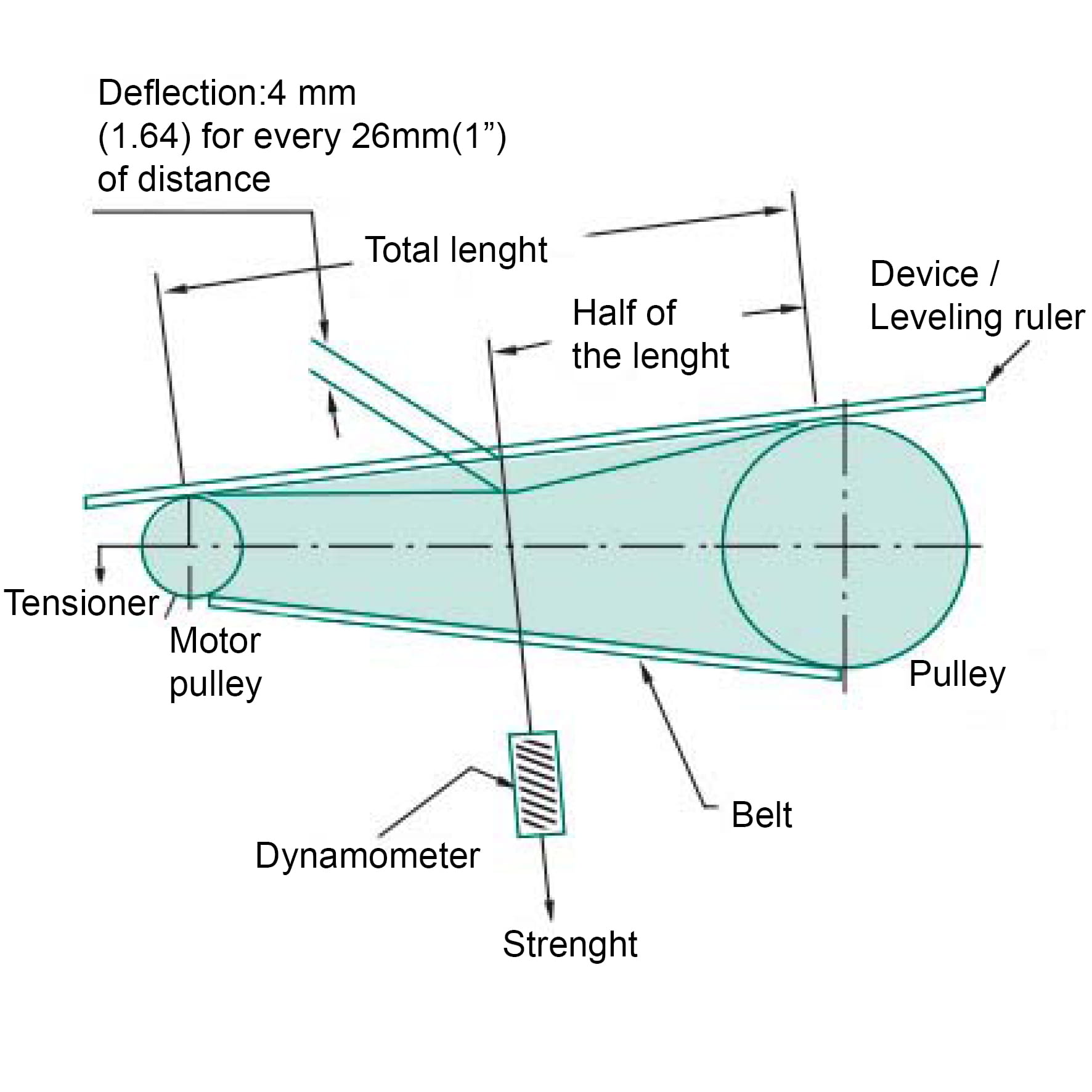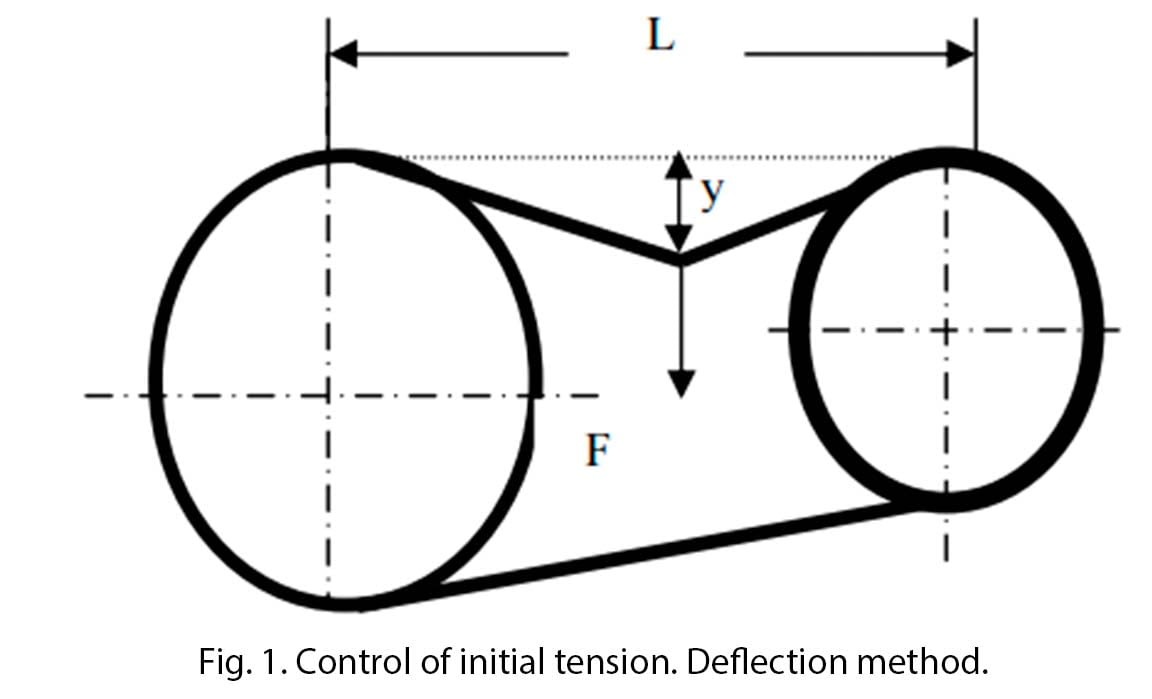Tensioning of transmission belts
 Tensioning of transmission belts
Tensioning of transmission belts

What is the correct procedure for tensioning power transmission belts?
Correct tensioning of the transmission belts undoubtedly brings many benefits and avoids several inconveniences.
We must always remember some basic rules:
● The ideal tension is the minimum possible, but rather the belt slides or “slips” on the pulley, considering the conditions when the equipment is subjected to the highest torque.
● Excessive tension reduces the life of the belts, bearings/bushings and can cause internal damage to the motor/equipment; On the other hand, low tension will cause slipping, generating excessive heat in the belts and causing premature failure;
● After changing the belts, check their tension in the first 48 hours of operation
● Make periodic inspections of the transmission assembly, correctly tensioning the belts when necessary
● For uniform belt tensioning, it is recommended not to mix different brands, install sets with diameters/lengths of the same series and not use new belts together with old belts.
● Using the equipment with one or more missing belts for extended periods can cause wear of the pulley channels and tensioning will not be ideal after replacing the belt assembly.
Initial tension control
Once the initial tension in the belt appropriate for the load to be transmitted has been calculated, the value of this tension must be oriented based on a control of the deformation of the belt under a force applied perpendicularly in the middle of the branch, as shown. shown in fig. 4. This control method is recommended for adjusting the initial tension on V-belts with widths up to 22 mm (C or SPC profiles) and is known as the deflection method.

Deflection Method
This method recommends controlling the initial tension of the belt taking as reference the value of the control force "F", which causes a constant deflection "y", as can be seen in figure 1. It is a procedure that is convenient to apply when It has a dynamometer for control. Generally, a constant deflection of 16 mm per meter of length "L" of the branch is oriented.

By performing a static analysis of the branch where the control of the initial assembly tension is carried out, it can be determined the control force "F" applied perpendicularly to the belt in the middle of the branch and which causes
a deflection "y" according to the following table:
|
Belt section |
Diameter of the |
Belt strenght used (N) (Kgf) |
|
|
|
|
SPZ |
56 a 71 |
16 |
1.6 |
20 |
2.0 |
|
75 a 90 |
18 |
1.8 |
22 |
2.2 |
|
|
95 a 125 |
20 |
2.0 |
25 |
2.5 |
|
|
> 125 |
22 |
2.2 |
28 |
2.8 |
|
|
SPA |
80 a 100 |
22 |
2.2 |
28 |
2.8 |
|
106 a 140 |
30 |
3.0 |
38 |
3.8 |
|
|
150 a 200 |
36 |
3.7 |
45 |
4.6 |
|
|
> 200 |
40 |
4.0 |
50 |
5.1 |
|
|
SPB |
112 a 160 |
40 |
4.0 |
50 |
5.1 |
|
170 a 225 |
50 |
5.1 |
62 |
6.3 |
|
|
236 a 355 |
62 |
6.3 |
77 |
7.9 |
|
|
más 355 |
65 |
6.6 |
81 |
8.3 |
|
|
SPC |
225 a 250 |
70 |
7.1 |
87 |
8.9 |
|
265 a 375 |
92 |
9.4 |
115 |
12.0 |
|
|
> 375 |
115 |
12.0 |
144 |
15.0 |
|
|
8V |
>= 335 |
150 |
15.0 |
190 |
19.0 |
|
Z |
56 a 100 |
5 a 75 |
0.5 a 1.5 |
|
|
|
A / AX |
80 a 140 |
10 a 15 |
1.0 a 1.5 |
|
|
|
B / BX |
125 a 200 |
20 a 30 |
2.0 a 3.1 |
|
|
|
C / CX |
200 a 400 |
40 a 60 |
4.1 a 6.1 |
|
|
|
D |
355 a 600 |
70 a 105 |
7.1 a 10.7 |
|
|
What should be taken into account when selecting a strap?
The most important parameters to take into account when selecting the most appropriate strap are the following:
Transmission torque
Rotation speed
Distance between axis
Reduction ratio
Temperature and lubrication conditions
What happens if the belt is too tight?
Excessive tension decreases the life of the bearing/bushing belts and can cause internal engine/equipment damage.
What happens if the belt is not tight enough?
Low tension will cause slippage, generating excessive heat in the belts and causing premature failure.




